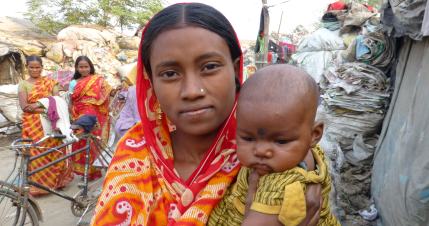- Passing on the Polio legacy- Social Mobilization Network Deployment to new locations
- Guidelines for the use of the Communication kit for the tOPV to bOPV SWITCH
- tOPV to bOPV SWITCH FAQs for Cold Chain Handlers and ANMs-English
- tOPV to bOPV FAQs for Cold Chain Handlers and ANMs-Hindi
- tOPV to bOPV SWITCH Fact Sheet-English
- tOPV to bOPV SWITCH Fact Sheet-Hindi
- tOPV to bOPV SWITCH Segregation Tape-Bilingual
- tOPV to bOPV SWITCH job aid for Cold Chain Points-English
- tOPV to bOPV SWITCH job aid for Cold Chain Points-Hindi
- tOPV to bOPV Poster for Cold Chain Points-English
- tOPV to bOPV Poster for Cold Chain Points-Hindi
- E-Brochure: Before the tOPV to bOPV SWITCH
- E-Brochure: After the tOPV to bOPV SWITCH
- SMSes for tOPV to bOPV SWITCH
Mobile & Migrant Strategy
Children on the move with their parents are particularly at risk of missing out on the oral polio vaccine. In the state of Bihar especially a significant proportion of the population is transient, moving from place to place for work or to attend large religious festivals. Determined to reach every last child, the polio programme has gone to them; vaccinating children at train stations, bus stands and busy intersections. Transit vaccinators visit sites where their parents are working; like brick kilns, construction sites and agricultural field huts. In the field huts of the Kosi River region in Bihar it was once common for 10% of the children to be missed during an immunization round - now, it’s less than one per cent.
Large Gatherings
Kiosks are set up and transit teams vaccinate children at large religious gatherings. During the Hindu festival of Chhath and Sonepur Mela in Bihar for example, thousands of transit mobilizers are deployed, distributing handbills with polio messages and hundreds of public address systems are set up to play polio messages. The campaign slogan “Wherever you are, wherever you go, immunize your child against polio with two drops, every time” reflects the strong focus on mobile, migrant and nomadic groups.
Border Vaccinations
India shares a highly porous border with Nepal, where child immunity levels against the polio virus are low. Polio was most recently carried from India into Nepal and back into India in 2010. Children crossing the Indo-Nepal border are now vaccinated around the clock at 81 vaccination posts, where almost six million children are vaccinated in a year, as well as at major intersections throughout UP and Bihar. Nepalese women support the UNICEF communication work, encouraging parents to vaccinate their children, speaking in local dialects and using bilingual communication materials. There are also five vaccination posts along the Indo-Pakistan border. Pakistan and Afghanistan are two of world’s three remaining polio endemic countries, so it’s a priority for children entering India from Pakistan to be given the oral polio vaccine. Further, round-the-clock vaccination continues at 14 railway stations in Bihar, where in the order of four million children are vaccinated in one year.
Tracking High Risk Groups
Migrants, nomads and slum dwellers are brought into the polio immunization system using a network of informers. These shopkeepers, brick kiln managers and others who have a sharp eye on who is coming and going from their communities, stay in touch with their local UNICEF Block Mobilization Coordinators, who ensure the nomadic groups are included in the micro-plan for the next polio immunization round. Vaccination teams are sent to the nomadic sites, to make sure the children living there aren’t missed. Special efforts have been made to form strong working relationships with the owners and managers of brick kilns and construction sites, to allow UNICEF mobilizers to visit and talk to the itinerant labourers living onsite about polio vaccination and other key health messages. Thousands of migrant and nomadic sites have been mapped across Uttar Pradesh and Bihar, so they are included in planning, and children do not miss out.
Mapping Nomadic Sites
In 2012, UNICEF’s polio programme mapped around 40,000 mobile and migrant sites (migrant settlements, nomadic sites, construction sites, brick kilns and slums) in UP and Bihar, and identified more than 22,000 informers (local shopkeepers, for example, or residents who contact SMNet high-risk group focal points when known nomadic sites are being inhabited near their location) to help the SMNet reach mobile groups with communication messages, and vaccination teams to reach them with the oral polio vaccine. On average 161,000 children are vaccinated in each supplementary immunization round, from 23,000 active sites.
Extra Resources
UNICEF has recruited 40 additional block-level SMNet members in UP and Bihar to identify and track high-risk groups and will expand this network further. As part of the tracking of migrant families 25,000 families have been identified and tracked for polio vaccination this year, out of which almost 7000 families have returned with almost 9,000 children. 63% of these children have been immunized during SIAs.
Transit Messaging
The programme continues to look for innovative ways to disseminate messages to the target audience of underserved and mobile populations. To this end, UNICEF works with AidMatrix to reach private-sector corporations keen to support the programme with Corporate Social Responsibility-funded interventions. In order to reach out to the migratory populations, AidMatrix places messaging on railways, transit hubs and other strategic locations, such as border areas, railways stations, bus stops, busy market places etc. It conducts communication outreach during major festivals, fairs and events across India through various innovative mediums, including audio & video messaging, IEC material outreach, and even getting polio messaging placed on products, such as sacks of rice, commonly used along the routes. Finally, it engages telecom companies for widespread communication, including SMS’s and voice calls to spread information about polio rounds and polio programme messaging among the people.



